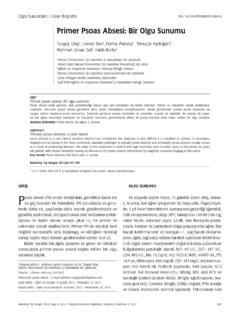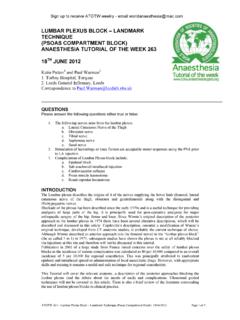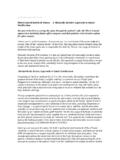Transcription of 4 5 6 Core Muscle Activation During Swiss Ball and ...
1 [ research report ]. Rafael F. Escamilla, PT, PhD, CSCS, FACSM1 Clare Lewis, PT, PsyD, MPH, MTC, FAAOMPT2 Duncan Bell, MPT3. Gwen Bramblet, MPT3 Jason Daffron, MPT3 Steve Lambert, MPT3 Amanda Pecson, MPT3. Rodney Imamura, PhD4 Lonnie Paulos, MD5 James R. Andrews, MD6. Core Muscle Activation During Swiss Ball and Traditional Abdominal Exercises T. he core has been used to refer to the lumbopelvic-hip latissimus dorsi, gluteus maximus and me- complex, which involves deeper muscles , such as the internal dius, hamstrings, and rectus ,24,25. Core Muscle development is believed to oblique, transversus abdominis, transversospinalis (multifidus, be important in many functional and rotatores, semispinalis), quadratus lumborum, and psoas major athletic activities, because core Muscle and minor, and superficial muscles , such as the rectus abdominis, recruitment should enhance core stabil- external oblique, erector spinae (iliocostalis, spinalis, longissimus), ity and help provide proximal stability to facilitate distal mobility.
2 For optimal core t STUDY DESIGN: Controlled laboratory study minis (53% and 55% MVIC, respectively), external stability, both the smaller, deeper core using a repeated-measures, counterbalanced oblique (46% and 84% MVIC, respectively), and muscles and the larger, superficial core design. internal oblique (46% and 56% MVIC, respectively) muscles must contract in sequence with t OBJECTIVES: To test the ability of 8 Swiss ball were significantly greater compared to most other appropriate timing and ,27 En- exercises, where EMG signals ranged between 7%. exercises (roll-out, pike, knee-up, skier, hip exten- hanced stability and neuromuscular con- to 53% MVIC for the upper rectus abdominis, 7%. sion right, hip extension left, decline push-up, and trol of the lumbopelvic-hip complex has to 44% MVIC for the lower rectus abdominis, 14%. sitting march right) and 2 traditional abdominal been shown to decrease the risk of knee to 73% MVIC for the external oblique, and 16% to exercises (crunch and bent-knee sit-up) on activat- 47% MVIC for the internal oblique.
3 The lowest EMG injuries, especially in ,37 Zazulak ing core (lumbopelvic hip complex) musculature. signals were consistently found in the sitting march et al37 reported that female athletes with t BACKGROUND: Numerous Swiss ball ab- right exercise. Latissimus dorsi EMG signals were less trunk control had a higher risk of dominal exercises are employed for core Muscle greatest in the pike, knee-up, skier, hip extension strengthening During training and rehabilitation, right and left, and decline push-up (17%-25%. knee injuries, especially anterior cruciate but there are minimal data to substantiate the MVIC), and least with the sitting march right, ligament injuries, compared to athletes ability of these exercises to recruit core muscles . crunch, and bent-knee sit-up exercises (7%-8% who exhibited greater trunk control. It is also unknown how core Muscle recruitment MVIC). Rectus femoris EMG signal was greatest The use of Swiss ball training for core in many of these Swiss ball exercises compares to with the hip extension left exercise (35% MVIC), Muscle development has been popular core Muscle recruitment in traditional abdominal and least with the crunch, roll-out, hip extension exercises such as the crunch and bent-knee sit-up.
4 For several Multiple studies have right, and decline push-up exercises (6%-10%. examined core Muscle recruitment dur- t METHODS: A convenience sample of 18 MVIC). Lumbar paraspinal EMG signal was relative subjects performed 5 repetitions for each exercise. low (less than 10% MVIC) for all exercises. ing varying types of Swiss ball abdominal Electromyographic (EMG) data were recorded on t CONCLUSIONS: The roll-out and pike were exercises8,28,35,36 and During traditional the right side for upper and lower rectus abdomi- the most effective exercises in activating upper abdominal exercises like the crunch nis, external and internal oblique, latissimus dorsi, and lower rectus abdominis, external and internal (abdominal curl-up) and bent-knee sit- lumbar paraspinals, and rectus femoris, and then obliques, and latissimus dorsi muscles , while mini- ,14,35,36 Most researchers who studied normalized using maximum voluntary isometric mizing lumbar paraspinals and rectus femoris ac- the use of Swiss ball exercises quanti- contractions (MVICs).
5 Tivity. J Orthop Sports Phys Ther 2010;40(5):265- fied abdominal Muscle activity During t RESULTS: EMG signals During the roll-out and 276. t KEY WORDS: crunch, EMG, low back pain, the crunch, push-up, and bench press pike exercises for the upper rectus abdominis (63%. and 46% MVIC, respectively), lower rectus abdo- lumbar spine, rectus abdominis, sit-up exercises, and typically investigated the recruitment patterns of only 1 or 2 mus- Andrews-Paulos Research and Education Institute, Gulf Breeze, FL; Professor, Department of Physical Therapy, California State University, Sacramento, Sacramento, CA. 2 Professor, 1 Department of Physical Therapy, California State University, Sacramento; Sacramento, CA. 3 Graduate Student, Department of Physical Therapy, California State University, Sacramento, Sacramento, CA. 4 Associate Professor, Kinesiology and Health Science Department, California State University, Sacramento, Sacramento, CA. 5 Medical Director, Andrews-Paulos Research and Education Institute, Gulf Breeze, FL.
6 6 Medical Director, American Sports Medicine Institute, Birmingham, AL; Medical Director, Andrews Institute, Gulf Breeze, FL. The protocol used in the current study was approved by the Institutional Review Board at California State University, Sacramento, CA. Address correspondence to Dr Rafael Escamilla, Department of Physical Therapy, California State University, Sacramento, 6000 J Street, Sacramento, CA 95819-6020. E-mail: journal of orthopaedic & sports physical therapy | volume 40 | number 5 | may 2010 | 265. 03 265 4/21/10 11:55:09 AM. [ research report ]. ,15,22,23,32 Numerous other Swiss ball exercises are used in training and reha- bilitation to enhance core development and stability. For example, prone hip extension performed on a Swiss ball is commonly used for gluteus maximus and hamstrings development. However, the FIGURE 1. Starting position for the pike, knee-up, extent that performing prone hip exten- skier, decline push-up, hip extension right, and hip sion on a Swiss ball recruits core muscles extension left.
7 Has not yet been investigated. Moreover, FIGURE 3. Ending position for the knee-up. there are several additional higher-level Swiss ball exercises that are used by ath- letes, such as the roll-out, pike, knee-out, and skier, but their effectiveness in re- cruiting core muscles is unknown. Many of these exercises are chosen based on functionality or sport specificity. Never- theless, it remains unclear how perform- ing traditional abdominal-strengthening exercises, such as the crunch and bent- knee sit-up, compares to performing a FIGURE 4. Ending position for the skier. progression of Swiss ball exercises, with FIGURE 2. Ending position for the pike. respect to core Muscle recruitment. Understanding which core muscles tension right, and hip extension left. Dur- are recruited and how active they are mal body fat for their age group, in accor- ing these exercises, the subject assumed while performing a variety of Swiss ball dance with standards set by the American a prone, neutral spine and pelvis push- and traditional abdominal exercises is College of Sports Medicine.
8 3 Baseline up position (hips, knees, elbows, and helpful to therapists and other healthcare skin fold calipers (model 68900; Country neck flexed approximately 0 , shoulders or fitness specialists who develop specific Technology, Inc, Gays Mill, WI) and ap- flexed approximately 90 , feet together, abdominal exercises for their patients or propriate regression equations were used and hands shoulder width apart), with clients to facilitate their rehabilitation or to assess percent body fat. Mean (SD) the center of the Swiss ball positioned training objectives. The purpose of this age, mass, height, and percent body fat under the legs approximately halfway study was to test the ability of 8 Swiss for females were ( ) years, ( ) between the knees and ankles. The pike ball abdominal exercises and 2 tradi- kg, ( ) cm, and ( ), re- was performed by flexing the hips ap- tional abdominal exercises on activating spectively, and ( ) years, ( ) proximately 90 to 100 , while keeping core muscles .
9 It was hypothesized that kg, ( ) cm, and ( ) for the knees fully extended (FIGURE 2). The normalized electromyographic (EMG) males, respectively. All subjects provided knee-up was performed by flexing both signals from core muscles would be sig- written informed consent in accordance the hips and knees approximately 90 to nificantly greater in Swiss ball exercises with the Institutional Review Board at 100 , with the knees moving towards the compared to traditional abdominal exer- California State University, Sacramento. chest (FIGURE 3). The skier was performed cises, and would be significantly less in Individuals were excluded from the study similarly to the knee-up, except that both the sitting march right exercise compared if they had a history of abdominal or back knees moved towards the right shoulder to the remaining Swiss ball exercises. pain or were unable to perform all exer- as the hips and knees flexed (FIGURE 4). cises pain-free, through their full range of During the pike, knee-up, and skier it was METHODS motion, and with proper form and tech- natural for slight trunk (spine) flexion to nique for 12 consecutive repetitions.
10 Occur. After the pike, knee-up, and skier Subjects movements were completed, the subject T. o optimize the quality of the Exercise Descriptions returned to the starting position. EMG signal collected, this study The 8 Swiss ball abdominal exercises During the decline push-up, simul- was limited to a convenience sample are shown in FIGURES 1 though 11. FIGURE 1 taneous elbow flexion and shoulder of 18 healthy, young subjects (9 male and shows the starting position for the pike, horizontal abduction occurred until just 9 female) who had normal or below nor- knee-up, skier, decline push-up, hip ex- before the subject's nose contacted the 266 | may 2010 | volume 40 | number 5 | journal of orthopaedic & sports physical therapy 03 266 4/21/10 11:55:11 AM. FIGURE 5. Ending position for the decline push-up. FIGURE 8. Starting position for the roll-out. FIGURE 6. Ending position for the hip extension right. FIGURE 11. Ending position for the sitting march right.







